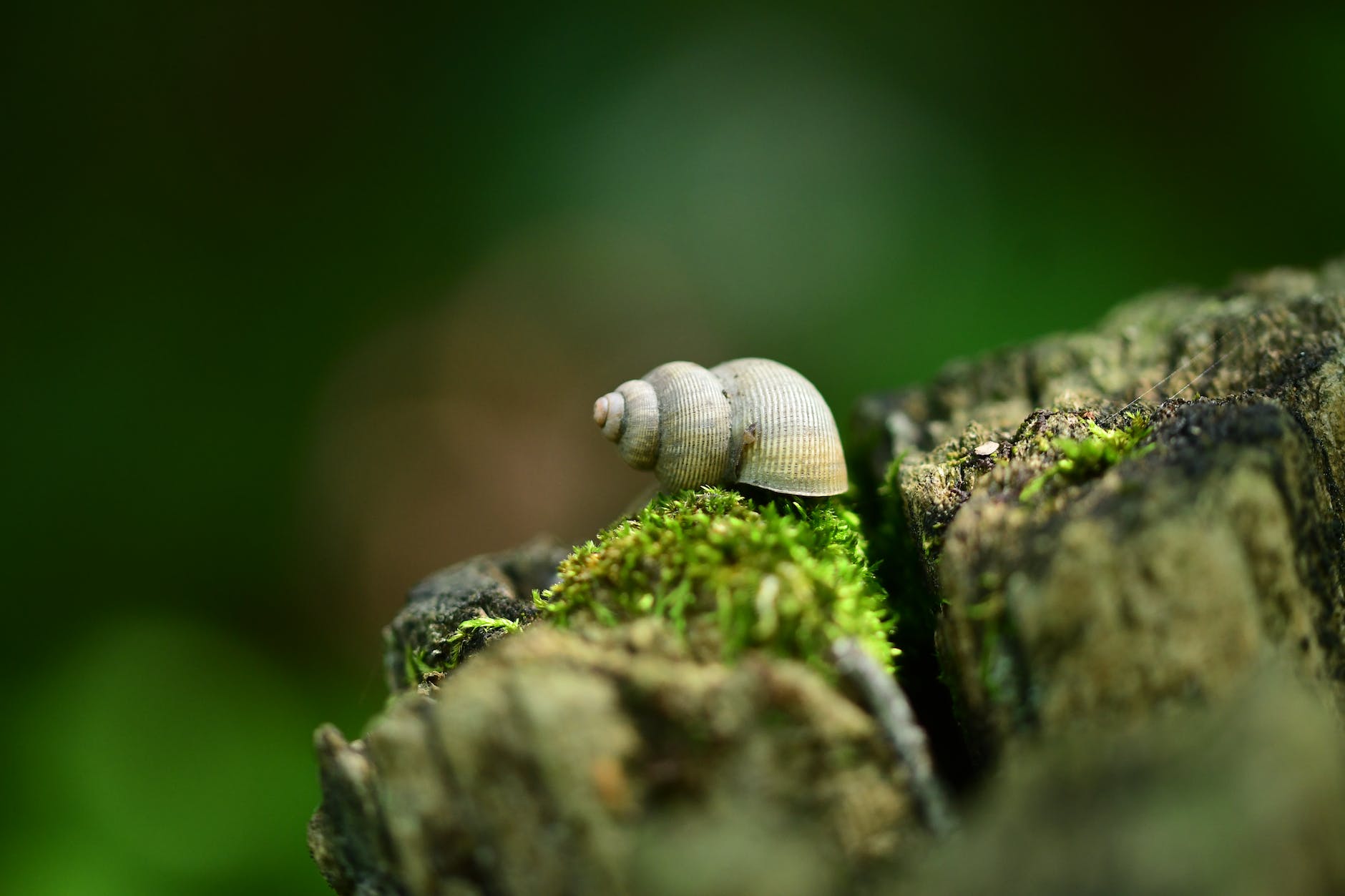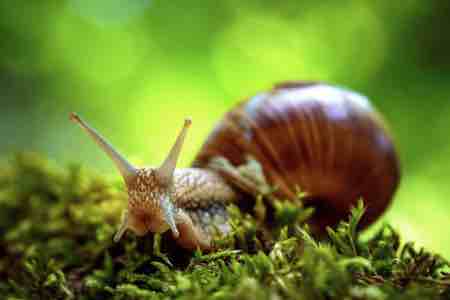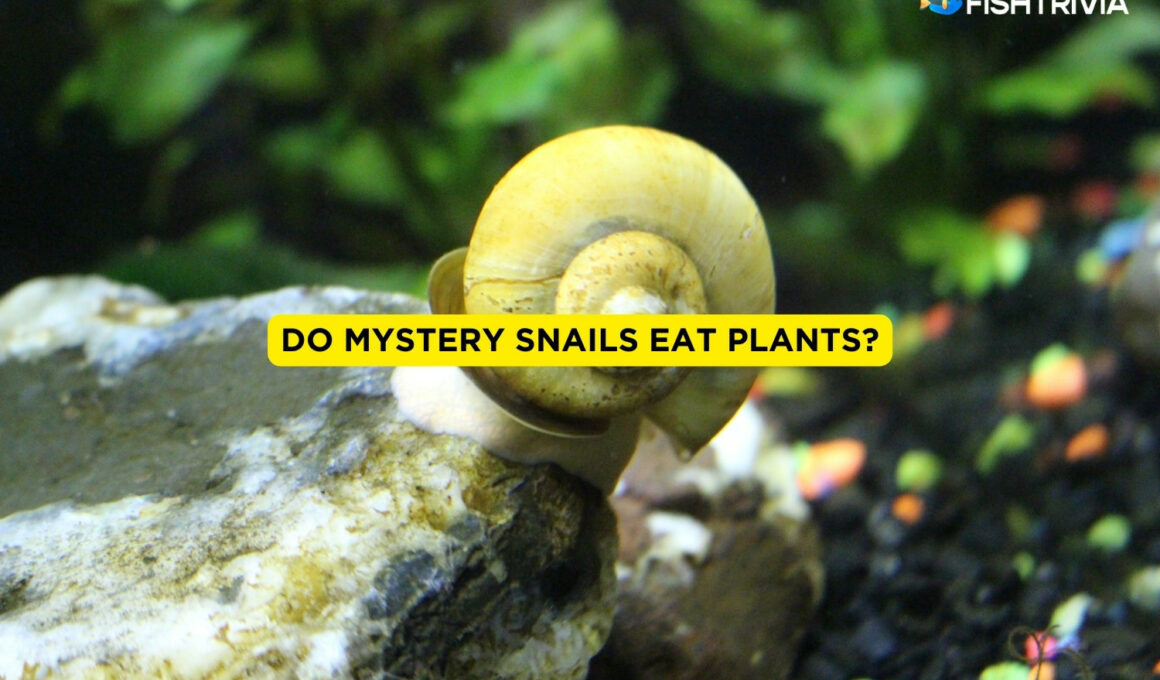In this article Show
As someone caring for fish and other aquatic life for years, I understand that a thriving aquarium is a delicate balance. Every creature in our tanks, from the fish to the tiniest snail, plays a role in maintaining this balance.
Speaking of snails, there’s one species that many of us have found intriguing – the Mystery Snail. These fascinating creatures add a touch of charm to our tanks, but there’s a question that frequently comes up: Do Mystery Snails eat plants?
It’s a valid concern. After all, we invest much time and effort into nurturing our aquatic plants. The last thing we want is for them to become snail food.
So, in this post, we will delve into the diet of Mystery Snails and answer that burning question. Whether you’re considering adding these snails to your tank, or if you’re just curious about their eating habits, this post is for you. Let’s dive in!
Understanding Mystery Snails
Mystery Snails, or Pomacea bridgesii, is a type of freshwater snail loved by aquarists for their unique behaviors and stunning appearances. Their name “Mystery Snail” is due to the “mystery” of when they would reproduce in the early days of keeping them as pets.
They originate from South America and are available in a range of colors, including gold, blue, and ivory. Mystery Snails are peaceful creatures, and they play a beneficial role in the aquarium ecosystem.
They help in the breakdown of organic matter and detritus, indirectly aiding in the nitrogen cycle that is crucial to maintaining water quality in a closed system like an aquarium.
One characteristic of Mystery Snails that draws many enthusiasts is their size. They are among the largest freshwater snails, growing up to 2 inches in diameter. This makes them quite noticeable in a tank setting, especially when they move around with their distinct slow pace, exploring surfaces with their long, flexible tentacles.
Mystery Snails are also known for their escapades outside the water. They can often be found climbing to the top of the tank, above the waterline. They have a special siphon, a kind of “snorkel,” that they use to breathe air, which is why you might spot them at the water’s surface from time to time.
As an experienced fish keeper, I’ve found that understanding these creatures and their behaviors can greatly enhance the experience of having them in your aquarium. Now that we know a bit more about who Mystery Snails are, let’s delve into their diet and eating habits.

Mystery Snails’ Diet
Understanding the natural diet of Mystery Snails can provide valuable insight into their potential impact on your aquarium plants. In the wild, Mystery Snails are detritivores, meaning their primary source of nutrition comes from consuming detritus or decaying organic material.
They enjoy a varied diet of dead and decaying plants, algae, and even dead animals. In essence, they serve as a kind of natural cleanup crew, contributing to the decomposition and recycling of organic matter in their environment.
In an aquarium setting, Mystery Snails continue to play this role. They are excellent algae eaters, often seen scraping the green growth off aquarium glass, decorations, and yes, even plants. They also readily consume leftover fish food, effectively helping to prevent the buildup of waste.
For a well-rounded diet, you can supplement their food intake with various aquatic snail food available in the market. They particularly enjoy sinking pellets, vegetable clips, and even blanched vegetables like carrots, spinach, or peas.
Calcium is also a crucial part of their diet, essential for maintaining their large and robust shells. Maintaining a balanced diet for your Mystery Snails keeps them healthy and helps mitigate any potential overfeeding of other aquarium inhabitants.
After all, a well-fed Mystery Snail is less likely to nibble on your precious plants. But does this mean Mystery Snails don’t eat live plants? Let’s unpack this question next.
Do Mystery Snails Eat Plants?
As an experienced aquarist, this is a question I’ve heard time and time again: do Mystery Snails eat plants? It’s a common concern for those of us who carefully cultivate aquatic plant life in our tanks. So, here’s the scoop.
Mystery Snails are not typically plant-eaters. As detritivores, their primary diet consists of decaying matter, algae, and leftover food, as we’ve discussed earlier. They’re more like scavengers than herbivores.
However, this doesn’t mean your plants are entirely safe. If a Mystery Snail is hungry and other food sources aren’t readily available, it might resort to nibbling on softer, more delicate plants. It’s not their first choice, but a hungry snail won’t be too picky.
It’s also important to note that sometimes what appears to be “eating” might actually be the snail cleaning your plants. Mystery Snails often graze on the surfaces of plants, not to consume the plant itself, but to eat the thin layer of algae and biofilm that grows on them.
In my many years of keeping these fascinating creatures, I’ve found that a well-fed Mystery Snail, given a proper diet and care, is unlikely to cause significant damage to healthy, mature plants. However, they might pose a threat to young, tender plants or those already weakened by other conditions.
To conclude, Mystery Snails can potentially eat plants, but they don’t usually do so unless food is scarce or the plants are already in poor condition. Still, it’s crucial to keep an eye on the dynamics in your tank to ensure a healthy environment for all its inhabitants.

Effects of Mystery Snails On Aquarium Plants
Mystery Snails are known to be peaceful and non-aggressive creatures, but does this mean they’re entirely harmless to aquarium plants? The answer isn’t as straightforward as one might think.
While Mystery Snails are not primarily plant eaters, their impact on plant life in an aquarium is undeniable. Their daily activities can both positively and negatively affect the health and growth of your plants.
Positive Impact
- Algae Control: Mystery Snails are effective at controlling algae growth. They consume the algae that commonly form on the leaves and stems of plants. This not only cleans your plants but also prevents excessive algae from outcompeting your plants for nutrients and light.
- Aeration: As Mystery Snails move through the substrate, they naturally aerate the tank’s bottom layers. This can benefit root-based plants by improving oxygen circulation and nutrient uptake.
Negative Impact
- Potential Plant Consumption: As discussed, if food is scarce, Mystery Snails might turn to your plants for sustenance. Soft, delicate, or young plants are particularly at risk.
- Physical Disturbance: The large size of Mystery Snails can occasionally lead to physical disturbances. As they move around, they may inadvertently uproot or displace smaller or newly planted flora.
As an experienced aquarium keeper, my advice is to observe your tank closely. Each tank’s environment is unique, and so is the behavior of the snails. By closely monitoring your Mystery Snails and their interaction with your plants, you can better understand their impact and take necessary actions when required.
How To Prevent Mystery Snails From Eating Plants
Based on my experience as an aquarist, preventing Mystery Snails from eating your plants is primarily about ensuring they have sufficient and appropriate food. Here are some strategies you can use:
1. Regular and Balanced Feeding
Mystery Snails are less likely to nibble on plants if they’re well-fed. Ensure you provide a balanced diet of algae wafers, sinking pellets, and occasional blanched vegetables.
2. Controlled Population
Overpopulation can increase the competition for food and lead to plant damage. If you notice an abundance of snails, consider reducing their numbers to maintain a balance in the tank.
3. Plant Choice
Choose plant species known for their hardiness and snail resistance. Varieties with thick leaves like Anubias or Java Fern can withstand occasional nibbling.
4. Provide Algae
Algae are a favorite food source for Mystery Snails. Consider cultivating some algae in your tank or adding algae wafers to their diet.
5. Remove Weak or Dead Plants
Mystery Snails are attracted to decaying organic matter. By promptly removing any dead or dying plants from your tank, you can prevent them from being an easy target.
6. Nutritional Supplements
Consider adding calcium supplements to your snails’ diet. Not only will this ensure healthy shell growth, but a satisfied snail is also less likely to turn to plants for nutrition.
Remember, the key is to understand your snails’ needs and keep an eye on their behavior. With proper care and attention, you can maintain a healthy, harmonious tank where both your snails and plants thrive.
Wrapping It Up
In the end, it comes down to this: Mystery Snails aren’t primarily plant-eaters, but they might turn to your plants if other food sources aren’t readily available. As aquarists, our task is to create a balanced and nutritious diet for these fascinating creatures to prevent potential damage to our beloved plants.
Understanding the nature and behavior of the inhabitants of your tank is essential to maintaining a healthy, thriving aquatic environment. By keeping a keen eye on the interactions in your aquarium, you can ensure a harmonious coexistence between your Mystery Snails and aquarium plants.






